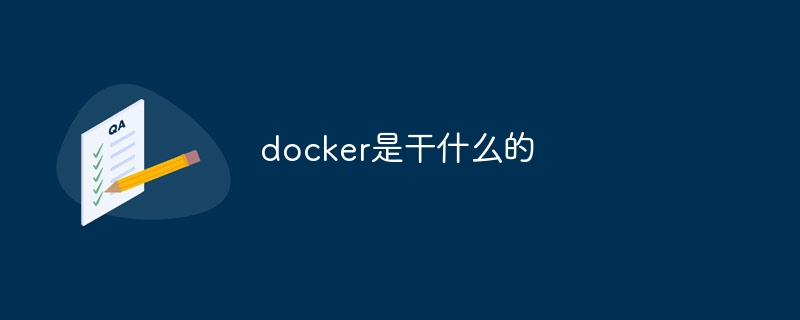What does docker do
Docker is an open source container engine for building, deploying, and running applications. Its features include: Containerization: Packaged applications and dependency isolation: Applications running in containers are isolated from each other Portability: Containers can be ported on different platforms and cloud environments Automation: Automation of applications using Dockerfile Build and deploy process microservices: Ideal for building and managing components in microservice architectures

Docker
Docker is an open source container engine for building, deploying, and running applications. It separates applications from infrastructure, allowing applications to be packaged and deployed independently of the operating system or hardware environment.
Docker features
Docker provides the following features:
- Containerization: Packages an application and its dependencies in a portable unit called a container.
- Isolation: Applications running in containers are isolated from each other and are not affected by the host or other containers.
- Portability: Containers can be ported on different platforms and cloud environments without modifying applications.
- Automation: Use Dockerfile to automate the application build and deployment process.
- Microservices: Docker is ideal for building and managing components in a microservice architecture.
The benefits of Docker
Docker provides the following benefits:
- Agility: Simplify application development and deployment through isolation and automation.
- Consistency: Ensure that the application runs consistently in different environments.
- Scalability: Easily deploy and scale applications to meet changing needs.
- Efficiency: Reduce resource usage and improve efficiency through containerization.
- Security: Isolated containers provide additional security layers to reduce application vulnerabilities.
The above is the detailed content of What does docker do. For more information, please follow other related articles on the PHP Chinese website!

Hot AI Tools

Undresser.AI Undress
AI-powered app for creating realistic nude photos

AI Clothes Remover
Online AI tool for removing clothes from photos.

Undress AI Tool
Undress images for free

Clothoff.io
AI clothes remover

Video Face Swap
Swap faces in any video effortlessly with our completely free AI face swap tool!

Hot Article

Hot Tools

Notepad++7.3.1
Easy-to-use and free code editor

SublimeText3 Chinese version
Chinese version, very easy to use

Zend Studio 13.0.1
Powerful PHP integrated development environment

Dreamweaver CS6
Visual web development tools

SublimeText3 Mac version
God-level code editing software (SublimeText3)

Hot Topics
 1655
1655
 14
14
 1413
1413
 52
52
 1306
1306
 25
25
 1252
1252
 29
29
 1226
1226
 24
24
 What is the main purpose of Linux?
Apr 16, 2025 am 12:19 AM
What is the main purpose of Linux?
Apr 16, 2025 am 12:19 AM
The main uses of Linux include: 1. Server operating system, 2. Embedded system, 3. Desktop operating system, 4. Development and testing environment. Linux excels in these areas, providing stability, security and efficient development tools.
 How to run sublime after writing the code
Apr 16, 2025 am 08:51 AM
How to run sublime after writing the code
Apr 16, 2025 am 08:51 AM
There are six ways to run code in Sublime: through hotkeys, menus, build systems, command lines, set default build systems, and custom build commands, and run individual files/projects by right-clicking on projects/files. The build system availability depends on the installation of Sublime Text.
 Can vscode compare two files
Apr 15, 2025 pm 08:15 PM
Can vscode compare two files
Apr 15, 2025 pm 08:15 PM
Yes, VS Code supports file comparison, providing multiple methods, including using context menus, shortcut keys, and support for advanced operations such as comparing different branches or remote files.
 git software installation
Apr 17, 2025 am 11:57 AM
git software installation
Apr 17, 2025 am 11:57 AM
Installing Git software includes the following steps: Download the installation package and run the installation package to verify the installation configuration Git installation Git Bash (Windows only)
 How to set important Git configuration global properties
Apr 17, 2025 pm 12:21 PM
How to set important Git configuration global properties
Apr 17, 2025 pm 12:21 PM
There are many ways to customize a development environment, but the global Git configuration file is one that is most likely to be used for custom settings such as usernames, emails, preferred text editors, and remote branches. Here are the key things you need to know about global Git configuration files.
 Docker on Linux: Containerization for Linux Systems
Apr 22, 2025 am 12:03 AM
Docker on Linux: Containerization for Linux Systems
Apr 22, 2025 am 12:03 AM
Docker is important on Linux because Linux is its native platform that provides rich tools and community support. 1. Install Docker: Use sudoapt-getupdate and sudoapt-getinstalldocker-cedocker-ce-clicotainerd.io. 2. Create and manage containers: Use dockerrun commands, such as dockerrun-d--namemynginx-p80:80nginx. 3. Write Dockerfile: Optimize the image size and use multi-stage construction. 4. Optimization and debugging: Use dockerlogs and dockerex
 Can vs code compile c
Apr 15, 2025 pm 08:12 PM
Can vs code compile c
Apr 15, 2025 pm 08:12 PM
VS Code can be used to compile C, and it has high efficiency and good debugging experience, thanks to its rich expansion ecosystem. The specific steps include: installing the C compiler (such as GCC, Clang). Install the C/C extension. Compile C code using a built-in terminal or build system such as CMake. Use the debugger to debug code. Improve development efficiency with code snippets and custom tasks.
 What is the difference between memory leaks in Java programs on ARM and x86 architecture CPUs?
Apr 19, 2025 pm 11:18 PM
What is the difference between memory leaks in Java programs on ARM and x86 architecture CPUs?
Apr 19, 2025 pm 11:18 PM
Analysis of memory leak phenomenon of Java programs on different architecture CPUs. This article will discuss a case where a Java program exhibits different memory behaviors on ARM and x86 architecture CPUs...




